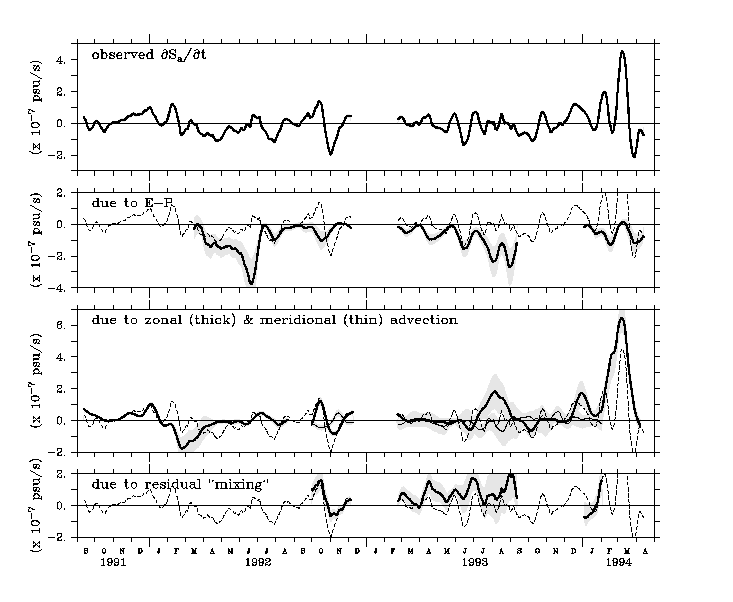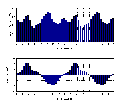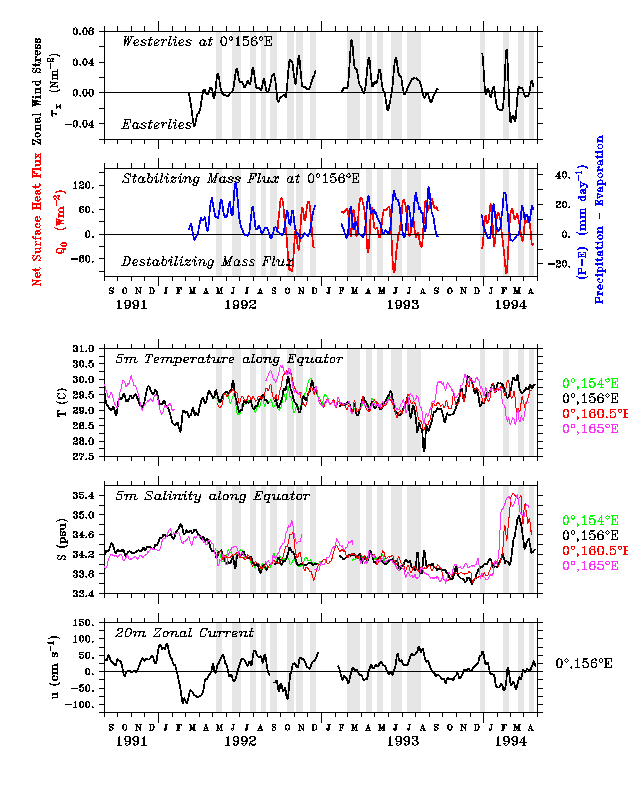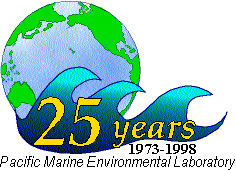TOGA-COARE Enhanced Monitoring Array Analyses
Salinity Balance Analyses
Meghan Cronin and Michael McPhaden, PMEL
Salinity Processing and Quality Control
Freitag, H.P., M. McCarty, C. Nosse, R. Lukas, M.J. McPhaden, and
M.F. Cronin, COARE SEACAT data: Calibration and quality control procedures.
NOAA Technical Memorandum ERL PMEL-115 , Pacific Marine
Environmental Laboratory, Seattle, WA, 89 pp., March 1999.
 |
This tech report describes the processing and quality control applied to
the salintiy data from twelve mooring sites as a part of the COARE EMA.
Primary sources of error were biological fouling, abrasive scouring of
the conductivity cell, and temperature/conductivity sensor response
time mismatch in the presence of high-frequency temperature variability
and low flush rate.
|
Salinity Balance in the Western Equatoral Pacific During COARE EMA
Cronin, M.F. and M. J. McPhaden, Upper ocean salinity balance in the western equatorial Pacific. J. Geophys. Res., 103, 27567-27587, 1998.
 |
Hourly data at 0o,156oE and daily
subsurface salinity from nearby moorings were used to evaluate nearly
all terms in the surface salinity balance for the 2-year period (Aug
91-Apr 94). Zonal advection was consistent with the concept of a
zonally migrating fresh pool and was the dominant process responsible
for surface salinity variability.
|
Diurnal Cycle of Salinity Balance in the Western Equatoral Pacific
Cronin, M. F. and M. J. McPhaden,
Diurnal cycle of rainfall and surface salinity in the western
Pacific warm pool. Geophys. Res. Let., 26, 3465-3468, 1999.
 |
The diurnal cycle of rainfall is closely linked to the diurnal cycle of
SST, with preferential rainfall both in the late afternoon and prior to
dawn. Although the afternoon rainfall results in anomalously fresh surface
salinity, nighttime mixing counteracts the predawn rainfall freshening.
Consequently, the surface salinity is anomalously high in the early morning
hours.
|
Buoyancy Effects of Heat and Freshwater
Cronin, M. F. and M. J. McPhaden, A comparison of the heat and
salinity balances at 0, 156E. In: COARE98 proceedings of a conference on the TOGA
Coupled Ocean-Atmosphere Response Experiment (COARE) (Boulder Colorado,
USA, 7-14-July 1998), WCRP-107, WMO/TD-No. 940, Geneva, Switzerland,
p. 303-304, 1999.

|
Westerly wind bursts are associated with high rainfall and a net surface
cooling, and thus the surface flux terms in the heat and salinity balances are
highly correlated. The response however is different in the two
balances due to the compensating vs. enhancing nature of mixing. During
WWB, mixing enhances the surface cooling, but counteracts the surface
freshening. As a result, zonal advection has a more dominant role in
the salinity balance, than in the heat balance.
|
../.././lab_review.html
Funding support provided by NOAA/OGP
1998 PMEL Science Review - http://www.pmel.noaa.gov/programs/98prog-agenda.html
Return
to COARE EMA Analyses Home Page



